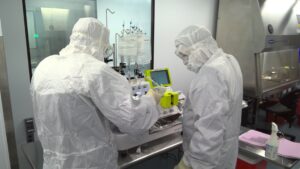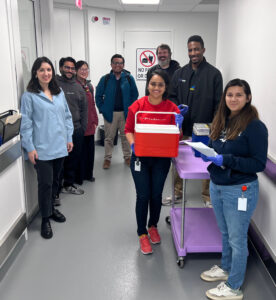Earlier this year, Vor Bio dosed its first patient with VCAR33ALLO, a transplant donor-derived CAR-T targeting CD33 in AML patients. VCAR33ALLO is manufactured at our in-house facility in Cambridge, MA, and Voracians were directly involved in every part of the process. We spoke with a few of the team members who participated in this momentous manufacturing run about what it meant to them to be part of the process.
Read our Q&A with our team members below:
- Matheus Cerdeira Pires – Manufacturing Specialist II
- Mary Swartz – Senior Director, Quality Control
- Jennifer Whangbo, MD, PhD – Director, Clinical Research & Development
Question: This was such an exciting moment for the company. Can you talk about what it was like for you and your team to reach this point where we are preparing a drug product to give to the first patient?
Jennifer: For me personally to be able to see the program from the beginning all the way to our first patient is tremendously meaningful. Over the course of a year, our Clinical team, along with many colleagues, developed the clinical trial protocol and selected and activated our clinical trial sites, so we are excited to get to this point where we are now treating patients. This is the moment that everyone’s been waiting for.
Question: Let’s back up and talk about the manufacturing process itself. Can you give us a brief explanation of what the process entails and how long it takes?
Matheus: The VCAR33ALLO process requires several steps and involves multiple teams. The whole manufacturing process takes about seven days. During that time we’re isolating and expanding our target cells and doing some culture evaluation processing. After about seven days, we then harvest and formulate our drug product.


Question: The Quality team is an integral part of this entire process. Can you explain how your team was involved throughout the run?
Mary: Quality is involved from the very first steps through the very last steps. We’re the last group that touches that product and releases it to be shipped to the patient. Within our team, there’s the Quality Assurance (QA) group, which is integrally involved with both manufacturing and Quality Control (QC), and then there’s QC, my team, which collects and tests samples during the manufacturing process to confirm the process is running as it should. At the end of the process, QC and Manufacturing are working very closely to ensure the proper dose is formulated and that the product is viable, potent, sterile, and safe.
Question: How did your teams prepare for this?
Matheus: All of our teams participated in multiple training runs so that we could anticipate any potential issues that could come up and develop solutions for them. We learned a lot from those runs. We prepared our personnel to be ready for this clinical manufacturing run so that when we manufactured our very first product, we knew exactly what we needed to do and the process was as smooth as it could be.
Mary: We did a lot of team building to make sure that we were ready for anything. There was a really good sense of calm, cool, and collected because the teams were so well-trained, well-equipped, had so much experience, and were just ready to do it. It was a true moment of fellowship with everybody pulling together, and it was seamless. It was one of the best production runs that I’ve had the opportunity to be involved in.
Question: What was it like knowing you were holding and manufacturing the cells that would be given to an AML patient?
Matheus: It’s a mixed feeling. You are happy because all your efforts have resulted in something that you can see and that could help someone. At the same time, you feel a lot of responsibility, a lot of pressure because there is someone out there waiting for that product to help them. So for me, it was really meaningful to hold the drug product in my hands and think about how this could save someone’s life. We all know someone that has AML or another kind of cancer, and we know how devastating the disease is, so knowing that you’re doing something about it means a lot.
Question: As someone who has treated cancer and transplant patients, what did it mean to you to be part of this manufacturing run?
Jennifer: As a physician, I’ve treated patients with CAR-T cells but had never seen the behind the scenes of how the CAR-T cells are made. And so being here for the start of the manufacturing run really gave me an appreciation for the incredible amount of time and effort that goes into developing these products. Carefully coordinated teamwork involving multiple functions is crucial to manufacturing these cellular therapies, and you can feel that everyone at Vor is hoping that our work will have a positive impact.
Question Collaboration is key to this process. What other teams in the organization contribute to these manufacturing runs?
Mary: You can pull a thread through the entire process and see that it touched every single team here at Vor. Everyone from Supply Chain, Facilities, Lab Ops, Process and Analytical Development, Finance, HR, Regulatory, even the people who brought in lunch and dinner and snacks – all of that motivated the teams that worked on this product to be inspired, to be ready to do it, to want to carry that for the team. And then there is the Discovery and Molecular Engineering (DME) team – it was their critical research that began and drove all of this work! I think you would be challenged to find a department within Vor that wasn’t critical and crucial to what the team accomplished in that first run, and what the teams are continuing to do.
